
Most girls do not engage in enough physical activity to support their health and wellbeing. However, all-girls schools, with their unique environment, are best placed to tackle this issue.
Physical education and sports are crucial for a young person’s holistic development. Regular participation in team and individual sports, fitness activities, and physical activity offers numerous benefits, including improved concentration, better social behaviour in the classroom, increased self-confidence and self-worth, and reduced stress. However, data from the Australian Institute of Health and Welfare (2021) reveals a concerning trend: many girls in Australia are not participating in adequate physical activity, which can have lasting health implications. All-girls schools, with their unique environment, can effectively tackle this issue. But, how?
Creating a nurturing environment for sports
For Emma Griffin, Head of Physical Education at MLC, inclusive and supportive PE classes are a defining part of an all-girls’ education. “Girls’ schools are uniquely positioned to tailor their environments, curricular and co-curricular offerings to best suit girls and young women,” says Emma.
At MLC, the focus is on creating a nurturing and empowering environment for physical education and sport. Michael Jenkins, Director of Sport at MLC, states, “We strive to provide an environment where girls feel confident and enthusiastic about participating in sport. By eliminating the pressures associated with mixed-gender activities and creating an inclusive, welcoming and fun environment, we allow our students to develop their skills and passion for physical activity in a supportive space. This is vital for maintaining or increasing their activity levels”.
Leadership and development
The 2018 Australian study, Hands Up for Gender Equality, identified three activities that predict self-confidence if students participate in them regularly: travel, team sport, and participation in leadership roles and leadership development. All-girls schools have an advantage over co-educational environments in both team sports and leadership roles.
“In an all-girls school, 100% of the opportunities are for girls, all the leadership roles are for girls, and girls across the College have positive female role models to look up to. Older girls and alumnae take on sport coaching roles for younger students and provide much needed encouragement,” says Emma.
Diverse health and fitness offerings
It’s also essential to consider co-curricular activities that resonate with girls’ interests. In addition to the 30+ sports that MLC offers, the Health and Fitness Program also provides diverse options to students beyond traditional competitive sports.
“The Health and Fitness program offers students more fitness options, in direct response to student feedback, within the safety and convenience of their school environment. We now offer yoga, Pilates, spin, and strength and conditioning classes on campus. These have been well attended since we launched the program; we currently have an average of 450 girls turning out each week,” says Michael.
Paving the way for a healthier future
Ensuring that school grounds and facilities are inviting and accessible provides a safe and familiar environment for girls to engage in physical activities, promoting continuous engagement throughout the year.
The construction of a new Physical Education and Sport Precinct announced earlier this year, will mark a significant milestone in MLC’s history. This bold project is a comprehensive approach to health, participation in physical exercise, well-being, and sporting excellence – the scope of which will set a new bar for independent girls’ schools in Australia.
With the current trend of insufficient physical activity among girls, the role of all-girls schools equipped with the facilities that girls desire and need becomes even more vital. By creating environments that cater specifically to girls’ needs and preferences, we can pave the way for a healthier, more active future for girls.







